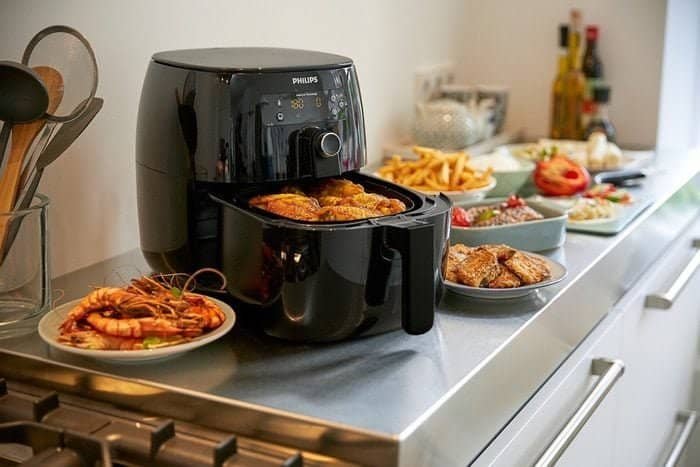
Air fryers have become a popular choice for those looking to enjoy delicious, crispy foods with a fraction of the oil traditionally used in frying. To make the Healthy Cooking with an Air Fryer, consider these tips and tricks:
Choose Lean Cuts of Meat for Healthy Cooking with an Air Fryer
- Opt for lean cuts of meat to reduce the overall fat content of your dishes. Skinless poultry, lean beef, and fish are excellent choices.
- Why Lean and Mean? 🥩
- Cutting the Fat: Lean meats are, well, lean on the fat content. That means you get all the protein without the unnecessary extras that may not be as friendly to your waistline.
- Healthier Heart: Opting for lean cuts can be kinder to your heart. You still get the essential nutrients without overloading on saturated fats.
- Crispy Goodness: In your air fryer, lean cuts can achieve that perfect crispy exterior without the excess oil. It’s like magic, but for your taste buds.
- Top Picks for Lean Meats: 🌟
- Chicken Breast:
- Why: It’s the poster child for lean protein. Versatile, cooks quickly, and takes on flavors like a culinary chameleon.
- Turkey Breast:
- Why: Another poultry champion. Lean and mean, and fantastic for making everything from burgers to kebabs.
- Pork Tenderloin:
- Why: As the “other white meat,” pork tenderloin is low in fat and can be incredibly tender when cooked right.
- Fish Fillets:
- Why: Fish is packed with omega-3 fatty acids and is naturally low in fat. Perfect for a quick and healthy meal.
- Ground Turkey or Chicken:
- Why: A lean alternative to beef for your tacos, burgers, or pasta sauces.
- Tips for Cooking Lean Meats in Your Air Fryer: 🍗
- Marination Magic: Tenderize and add flavor by marinating your lean meats before air frying. This is where the magic happens.
- Spritz, Don’t Saturate: Use an oil sprayer to lightly coat your meats. This ensures they crisp up without drowning in oil.
- Even Cookery: Arrange your meats in a single layer. This way, each piece gets the hot air treatment equally, ensuring an even cook.
- Temperature Check: Invest in a meat thermometer. It’s your secret weapon for ensuring your lean meats are cooked to perfection without drying out.
2. Use Minimal Oil:
- While air fryers require less oil than traditional frying, you can further minimize it. Invest in a quality oil sprayer to lightly coat your food, or use a brush to apply a thin layer of oil.
- Why Minimal Oil? 🌿
- Healthier Living: Let’s be real – we all want to savor the deliciousness without the guilt. Using minimal oil is a game-changer for a healthier lifestyle.
- Calorie Consciousness: Oil adds up in the calorie department. By keeping it minimal, you’re making a conscious choice to control your calorie intake.
- Crispy Magic: Believe it or not, a little oil goes a long way in the air fryer. It’s the secret sauce for achieving that golden, crispy texture without the need for a deep fryer.
- How to Master the Art of Minimal Oil: 🍳
- Invest in an Oil Sprayer:
- Why: It’s like a magic wand for portion control. An oil sprayer lets you distribute just enough oil to get the job done.
- Brush It On:
- Why: A silicone brush is your friend. Use it to lightly coat your food with a thin layer of oil. Precision is key!
- Opt for Heart-Healthy Oils:
- Why: When you do use oil, go for the good stuff. Olive oil, avocado oil – these not only add flavor but bring along health benefits too.
- Use High-Fat Ingredients Sparingly:
- Why: If your dish includes naturally high-fat ingredients like bacon or sausage, you might need even less added oil. Let the fats do the talking.
- Go Dry with Dry Ingredients:
- Why: For dry ingredients like fries or coated chicken, toss them in a bit of oil in a bowl before placing them in the air fryer. It ensures an even coating without excess.
- Top Picks for Minimal Oil Wonders: 🌟
- Sweet Potato Fries:
- How: Toss them in a bowl with a smidge of oil and your favorite seasonings.
- Brussels Sprouts:
- How: A light drizzle of oil, a sprinkle of salt, and you’re on your way to crispy goodness.
- Chicken Wings:
- How: Brush on a thin layer of oil mixed with your preferred wing sauce for a flavorful kick.
- Vegetable Medley:
- How: A quick spray of oil, some herbs, and your veggies are ready to roast.
3. Experiment with Healthy Oil Alternatives:
- Try using heart-healthy oils like olive oil or avocado oil. These oils add flavor while providing beneficial monounsaturated fats.
- Why Healthy Oil Alternatives? 🌱
- Heart-Healthy Goodness: Many traditional oils are high in saturated fats. Opting for healthier alternatives brings in those good fats – the ones that play nice with your heart.
- Rich in Nutrients: Healthy oils often come with a bonus – nutrients! From antioxidants to omega-3 fatty acids, these oils bring more to the table than just flavor.
- Flavor Boost: Each healthy oil alternative comes with its unique flavor profile. It’s like discovering a new spice for your kitchen – a subtle twist that elevates your dishes.
- Top Picks for Healthy Oil Alternatives: 🌟
- Olive Oil:
- Why: A classic, heart-healthy choice. Extra virgin olive oil is rich in monounsaturated fats and adds a delightful fruity note to your dishes.
- Avocado Oil:
- Why: With a high smoke point, avocado oil is perfect for air frying. It’s rich, creamy, and packs a nutrient punch.
- Coconut Oil:
- Why: While higher in saturated fats, coconut oil can be a healthier option in moderation. It adds a distinct coconut flavor and is fantastic for certain dishes.
- Grapeseed Oil:
- Why: Neutral in flavor and high in polyunsaturated fats, grapeseed oil is a versatile choice for various cooking methods.
- Flaxseed Oil:
- Why: A powerhouse of omega-3 fatty acids. Use it cold in dressings or drizzle it over finished dishes for a nutty flavor.
- How to Experiment with Healthy Oil Alternatives: 🍽️
- Salad Dressing Swirl:
- How: Mix olive oil with balsamic vinegar or lemon juice for a zesty salad dressing.
- Avocado Oil Marinade:
- How: Marinate meats or veggies in a mix of avocado oil, garlic, and your favorite herbs.
- Coconut Oil Infusions:
- How: Melt coconut oil and infuse it with herbs or spices for a tropical kick to your sautéed dishes.
- Grapeseed Oil Stir-Fry:
- How: Use grapeseed oil for stir-frying; its neutral flavor won’t overshadow your veggies.
- Flaxseed Oil Drizzle:
- How: Drizzle flaxseed oil over finished dishes like roasted vegetables or cooked grains for a nutritional boost.
4. Embrace Whole Foods:
- Air fryers work well with whole, unprocessed foods. Prepare fresh vegetables, whole grains, and unprocessed proteins to maximize the nutritional value of your meals.
- Why Embrace Whole Foods? 🍏
- Nutrient Powerhouse: Whole foods are like nature’s multivitamin. Packed with essential nutrients, they provide a wide array of vitamins, minerals, and antioxidants.
- Fiber Friends: Whole foods, especially fruits, vegetables, and whole grains, are rich in dietary fiber. Fiber keeps your digestive system happy and helps maintain a healthy weight.
- Less Processed Drama: Whole foods are, well, whole! They’re in their natural state, free from the additives, preservatives, and refined sugars often found in processed foods.
- Top Picks for Whole Food Wonders: 🌽
- Colorful Veggies:
- Why: Bell peppers, leafy greens, carrots – the more colors, the better. They bring a variety of nutrients to the table.
- Fruits Galore:
- Why: Berries, apples, bananas – whole fruits are nature’s sweet treats, loaded with vitamins and fiber.
- Whole Grains:
- Why: Quinoa, brown rice, oats – these grains retain their bran and germ, offering more fiber and nutrients than refined grains.
- Lean Proteins:
- Why: Chicken breast, fish, tofu – opt for unprocessed proteins for a lean and mean culinary experience.
- Nuts and Seeds:
- Why: Almonds, chia seeds, flaxseeds – these tiny powerhouses are packed with healthy fats, protein, and fiber.
- How to Embrace Whole Foods in Your Cooking: 🥦
- Shop the Perimeter:
- How: In most grocery stores, the fresh produce, meats, and dairy are around the perimeter. That’s where the whole foods party is!
- Bulk Up on Grains:
- How: Choose whole grains like quinoa, bulgur, or farro for your meals. They add a nutty flavor and a nutritional boost.
- Snack Smart:
- How: Instead of reaching for packaged snacks, munch on whole foods like apple slices with nut butter or a handful of nuts.
- Creative Veggie Swaps:
- How: Use veggie noodles or cauliflower rice as alternatives to refined grains. They add nutrition and a pop of color to your plate.
- Seasonal Sensations:
- How: Embrace seasonal produce for optimal freshness and flavor. It’s like bringing a burst of nature to your meals.
5. Add Flavor with Herbs and Spices:
- Enhance the taste of your dishes without extra calories by using herbs, spices, and seasoning blends. Experiment with various combinations for a burst of flavor.
- Why Add Herbs and Spices? 🌿🌶️
- Flavor Explosion: Herbs and spices bring a symphony of flavors to your dishes. They can turn a simple meal into a taste sensation.
- Health Boost: Many herbs and spices boast health benefits. From anti-inflammatory properties to antioxidants, they’re like little superfoods for your recipes.
- Culinary Creativity: This is your chance to get creative! Herbs and spices allow you to experiment and tailor your dishes to your unique taste preferences.
- Top Picks for Herb and Spice Marvels: 🌟
- Basil:
- Why: Fresh and aromatic, basil is perfect for Italian dishes, salads, and even infused oils.
- Cumin:
- Why: Earthy and warm, cumin adds depth to Mexican, Indian, and Middle Eastern cuisines.
- Rosemary:
- Why: Fragrant and pine-like, rosemary pairs beautifully with roasted meats, potatoes, and even bread.
- Turmeric:
- Why: Known for its vibrant color and earthy flavor, turmeric is a staple in many curry dishes and offers anti-inflammatory benefits.
- Cinnamon:
- Why: Warm and sweet, cinnamon is a must for both sweet and savory dishes, from desserts to stews.
- How to Master the Art of Herbs and Spices: 🌶️🍃
- Fresh is Fantastic:
- How: Use fresh herbs like parsley, cilantro, or chives to add a burst of freshness at the end of cooking or as a garnish.
- Layer Your Flavors:
- How: Start with foundational herbs like thyme or oregano and layer on with more delicate ones like parsley or basil towards the end.
- Pairing Perfection:
- How: Understand flavor pairings. For instance, coriander and cumin often work well together, as do basil and tomatoes.
- Experiment with Blends:
- How: Create your spice blends for signature dishes. Mix cumin, coriander, and chili powder for a homemade taco seasoning.
- Go Beyond the Basics:
- How: Don’t be afraid to explore less common herbs and spices like cardamom, za’atar, or tarragon for a unique twist.
6. Prevent Overcrowding:
- For even cooking and crispy results, avoid overcrowding the air fryer basket. Cook in batches if needed, giving each piece of food ample space.
- Why Prevent Overcrowding? 🍲
- Even Cooking: Each ingredient deserves its spotlight. Overcrowding leads to a fight for attention, resulting in uneven cooking – some bits too crispy, others not enough.
- Crispy Consistency: Especially crucial in the air fryer realm, preventing overcrowding ensures that each piece gets its fair share of hot air, achieving that perfect, crispy texture.
- Avoid the Steamy Situation: Too many ingredients huddling together create a steamy environment. Steam is the nemesis of crispiness – it leads to a sad, soggy outcome.
- How to Prevent Overcrowding Like a Pro: 🍳
- Give ‘Em Space:
- How: Whether it’s on a baking sheet, in a pan, or the air fryer basket – spread out your ingredients. They need room to breathe and crisp up.
- Batch Cooking FTW:
- How: If you’re cooking for a crowd, embrace the art of batch cooking. Cook in smaller batches to maintain quality.
- Single Layer Serenity:
- How: Aim for a single layer of ingredients. This allows each piece to have direct access to the heat source, ensuring uniform cooking.
- No Pile-Ups:
- How: Resist the urge to create ingredient mountains. Piling up leads to shadowy spots, and no one likes a gloomy potato wedge.
- Stirring Solution:
- How: If you’re dealing with a large quantity, stir or toss midway through cooking. This ensures that every piece gets its time in the spotlight
7. Include a Variety of Vegetables:
Why Include a Variety of Vegetables? 🌈
- Nutrient Bonanza: Different veggies bring different nutrients to the table. By including a variety, you ensure your body gets a diverse range of vitamins, minerals, and antioxidants.
- Flavorful Symphony: Each vegetable has its unique flavor profile. Mixing them up creates a symphony of tastes, adding depth and excitement to your dishes.
- Colorful Health Boost: The vibrant colors of vegetables often indicate their unique health benefits. Red peppers, for example, bring vitamin C, while leafy greens offer a dose of iron and fiber.
Top Picks for a Veggie Extravaganza: 🌽🍆
- Leafy Greens:
- Why: Spinach, kale, arugula – rich in iron, calcium, and a host of vitamins.
- Colorful Bell Peppers:
- Why: Red, yellow, green – each brings its unique sweetness and a burst of vitamins.
- Cruciferous Champions:
- Why: Broccoli, cauliflower, Brussels sprouts – these are your go-to for fiber and cancer-fighting compounds.
- Root Vegetables:
- Why: Carrots, sweet potatoes, beets – packed with beta-carotene, fiber, and natural sweetness.
- Allium All-Stars:
- Why: Onions, garlic, leeks – not just for flavor; they bring anti-inflammatory and immune-boosting properties.
How to Create a Veggie Extravaganza: 🥦🌽
- Rainbow Stir-Fry:
- How: Stir-fry a mix of bell peppers, broccoli, carrots, and snap peas for a colorful, crunchy delight.
- Leafy Green Power Salad:
- How: Combine spinach, kale, arugula with cherry tomatoes, cucumber, and a sprinkle of feta for a nutrient-packed salad.
- Roasted Medley:
- How: Toss together sweet potatoes, Brussels sprouts, and red onions with olive oil and your favorite herbs before roasting.
- Veggie-loaded Pasta:
- How: Mix zucchini noodles with cherry tomatoes, mushrooms, and spinach for a light and veggie-rich pasta dish.
- Stuffed Peppers:
- How: Fill bell peppers with a mix of quinoa, black beans, corn, and tomatoes for a wholesome, colorful meal.
- Load up on vegetables for added vitamins and minerals. Many vegetables, such as sweet potatoes, Brussels sprouts, and zucchini, become delightfully crispy in the air fryer.
8. Limit Processed Ingredients:
- Minimize the use of processed ingredients, such as pre-packaged frozen foods. Opt for fresh, whole ingredients to control your intake of additives and preservatives.
- Why Limit Processed Ingredients? 🚫🔄
- Nutrient Rich: Whole foods retain their natural goodness – the vitamins, minerals, and fiber that might be lost in the processing of packaged goods.
- Cut Down on Additives: Processed foods often come with a laundry list of additives, preservatives, and flavor enhancers. By opting for whole ingredients, you’re sidestepping the chemical drama.
- Healthier Heart: Whole foods, especially fruits, vegetables, and whole grains, can contribute to heart health by providing essential nutrients and dietary fiber.
- How to Navigate Towards Whole Ingredients: 🍎🥦
- Shop the Perimeter:
- How: In most grocery stores, the perimeter is where you’ll find fresh produce, meats, and dairy – your go-to for minimally processed options.
- Read Labels Carefully:
- How: If you venture into the middle aisles, scrutinize labels. Choose products with shorter ingredient lists, and avoid those with mysterious-sounding additives.
- DIY Where You Can:
- How: Instead of reaching for pre-packaged meals, sauces, or snacks, try making them from scratch. It’s often simpler than you think!
- Opt for Whole Grains:
- How: Choose whole grains like brown rice, quinoa, and oats over their refined counterparts. They bring more fiber and nutrients to the table.
- Minimize Sugary Additions:
- How: Processed foods often hide a lot of sugar. Embrace the natural sweetness of fruits and limit added sugars where you can.
- Incorporate Whole Ingredients into Everyday Cooking: 🍲👩🍳
- Simple Salads:
- How: Create salads with fresh greens, colorful veggies, nuts, and a simple olive oil and lemon dressing.
- DIY Smoothie Bowls:
- How: Blend together fresh fruits, Greek yogurt, and a sprinkle of nuts for a nutritious and unprocessed breakfast.
- Grilled Protein with Veggies:
- How: Grill chicken or fish with a medley of fresh vegetables for a straightforward, yet flavorful, meal.
- Whole Grain Delight:
- How: Swap out white bread for whole grain options in sandwiches or opt for whole grain pasta and rice.
- Homemade Salsa:
- How: Make your own salsa using tomatoes, onions, cilantro, and lime. It’s a burst of freshness without the need for preservatives.
9. Monitor Cooking Time:
- Keep a close eye on your food while it cooks. Air fryers work quickly, and it’s easy to overcook, resulting in a less-than-ideal texture.
- Why Monitor Cooking Time? ⏰
- Avoid Overcooking: Some ingredients are like fine wines – they don’t get better with age. Overcooked veggies, dry chicken, or rubbery pasta are kitchen tragedies that can be averted by keeping a close eye on the clock.
- Ensure Even Cooking: Different ingredients have different cooking times. By monitoring time, you ensure that each component of your dish gets the attention it deserves, resulting in a harmonious blend of textures and flavors.
- Safety First: Undercooked meats pose a risk of foodborne illnesses, while overcooked foods can lose essential nutrients. Monitoring cooking time is a crucial step in ensuring both safety and nutritional value.
- How to Master the Art of Monitoring Cooking Time: 🕒👩🍳
- Set Timers:
- How: Invest in a good kitchen timer or use the one on your phone. Set specific timers for each element of your meal to stay on top of the cooking process.
- Use a Meat Thermometer:
- How: For proteins like chicken or steak, a meat thermometer is your best friend. It takes the guesswork out of determining doneness.
- Prep in Advance:
- How: Have all your ingredients chopped, measured, and ready before you start cooking. This helps streamline the process and ensures you’re ready to move swiftly.
- Follow Recipes Closely:
- How: If you’re using a recipe, pay attention to suggested cooking times. Adjust based on your own experience and the quirks of your kitchen appliances.
- Keep an Eye and Nose Open:
- How: Visual cues and aromas can be excellent indicators of doneness. If something smells heavenly and looks golden brown, it’s probably ready.
- Incorporate Time Monitoring into Different Cooking Methods: 🥩🍲
- Grilling:
- How: Keep a close eye on grill times, flipping meats and veggies at appropriate intervals to achieve that perfect char.
- Roasting:
- How: Rotate pans halfway through roasting to ensure even cooking. Use a meat thermometer to check the internal temperature of larger cuts.
- Boiling/Poaching:
- How: Set a timer for boiling eggs or simmering pasta. Overcooked eggs and mushy pasta are avoidable with precise timing.
- Sauteing/Stir-Frying:
- How: Stir frequently, and adjust heat levels as needed. It’s a quick-cooking method where every minute counts.
- Baking:
- How: Keep a close eye on baked goods, especially as they approach the end of the recommended baking time. Use a toothpick to check for doneness
10. Utilize the Dehydrate Function
Imagine your air fryer as a multitasking genius. In addition to air frying, roasting, and baking, many modern air fryers come equipped with a Dehydrate Function. This function harnesses low temperatures and consistent airflow to remove moisture from your food, preserving it in a deliciously crisp state.
FAQs:
Here are Frequently asked questions about Healthy Cooking with an Air Fryer
1. Is air frying really healthier than traditional frying?
Answer: Yes, air frying is generally considered healthier than traditional frying. It uses hot air circulation to cook food, requiring significantly less oil compared to deep frying. This results in lower fat content while still achieving a crispy texture.
2. Can I use any type of oil in an air fryer?
Answer: Yes, you can use a variety of oils, but it’s recommended to choose oils with high smoke points to prevent burning. Healthy options include olive oil, avocado oil, or canola oil. Using an oil sprayer or brush helps control and minimize the amount of oil used.
3. How do I prevent my food from drying out in the air fryer?
Answer: To prevent food from drying out, consider marinating proteins before air frying, use a light coating of oil, and be mindful of cooking times. Adding moisture-rich ingredients like vegetables or spritzing water during cooking can also help retain moisture.
4. Can I cook frozen foods directly in the air fryer?
Answer: Yes, many frozen foods can be cooked directly in the air fryer without thawing. However, you may need to adjust cooking times and temperatures based on the specific food item. It’s recommended to consult the air fryer’s manual for guidelines.
5. Are there any foods that aren’t suitable for air frying?
Answer: While air fryers are versatile, some foods may not yield the desired results. Foods with high water content, like grapes or watermelon, may not air fry well. Additionally, battered foods might not achieve the same texture as deep frying. It’s essential to experiment and adapt recipes for optimal air frying.




